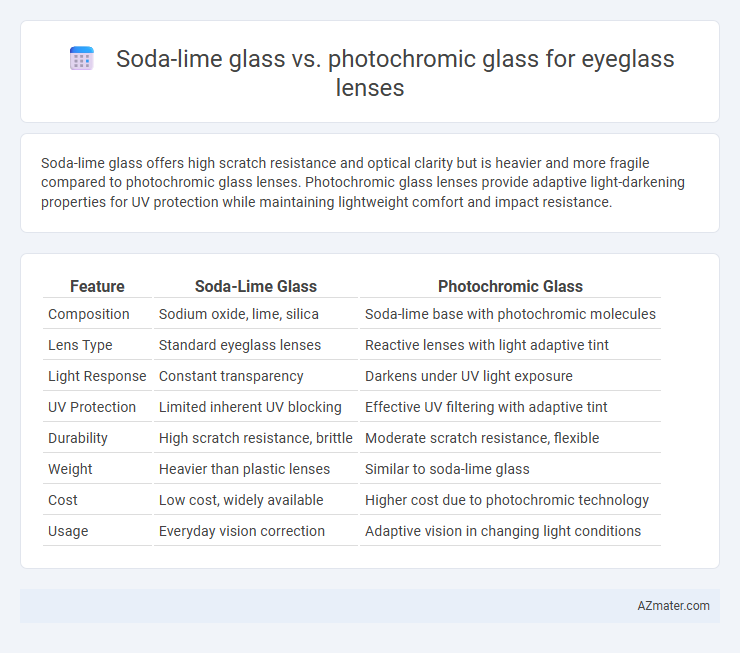Soda-lime glass offers high scratch resistance and optical clarity but is heavier and more fragile compared to photochromic glass lenses. Photochromic glass lenses provide adaptive light-darkening properties for UV protection while maintaining lightweight comfort and impact resistance.
Table of Comparison
| Feature | Soda-Lime Glass | Photochromic Glass |
|---|---|---|
| Composition | Sodium oxide, lime, silica | Soda-lime base with photochromic molecules |
| Lens Type | Standard eyeglass lenses | Reactive lenses with light adaptive tint |
| Light Response | Constant transparency | Darkens under UV light exposure |
| UV Protection | Limited inherent UV blocking | Effective UV filtering with adaptive tint |
| Durability | High scratch resistance, brittle | Moderate scratch resistance, flexible |
| Weight | Heavier than plastic lenses | Similar to soda-lime glass |
| Cost | Low cost, widely available | Higher cost due to photochromic technology |
| Usage | Everyday vision correction | Adaptive vision in changing light conditions |
Introduction to Eyeglass Lens Materials
Soda-lime glass in eyeglass lenses offers high optical clarity and scratch resistance due to its dense silica and soda-lime composition but tends to be heavier and more fragile compared to other materials. Photochromic glass lenses incorporate light-sensitive silver halide or silver chloride compounds that darken upon UV exposure, providing convenience with adaptive tinting while maintaining durability. Both materials present distinct advantages in eyewear, balancing weight, optical performance, and adaptive functionality for various user needs.
What is Soda-Lime Glass?
Soda-lime glass is a type of common glass made primarily from silica, soda ash, and lime, known for its affordability and ease of manufacture. It offers good optical clarity and durability but lacks specialized features like UV protection or light adaptation. In contrast, photochromic glass contains molecules that react to UV light, darkening outdoors and providing dynamic vision enhancement by reducing glare and protecting eyes from harmful rays.
What is Photochromic Glass?
Photochromic glass is a type of eyeglass lens that darkens automatically when exposed to ultraviolet (UV) light, providing adaptive protection against sunlight. Unlike soda-lime glass, which is primarily composed of silica, soda ash, and lime with fixed transparency, photochromic lenses contain embedded photochromic molecules that change structure under UV radiation, offering convenience and UV protection. These lenses enhance visual comfort by reducing glare and eliminating the need to switch between regular and sunglasses, making them ideal for outdoor activities.
Optical Properties Comparison
Soda-lime glass lenses offer excellent optical clarity and high scratch resistance due to their dense molecular structure but tend to be heavier and less impact resistant compared to photochromic glass lenses. Photochromic glass lenses dynamically adjust tint based on UV exposure, providing superior light adaptation and reducing glare, although they may exhibit slight color distortion and longer transition times under varying lighting. Optical performance in terms of refractive index is typically higher for soda-lime glass (around 1.52) than photochromic variants, influencing lens thickness and weight in eyeglass design.
Durability and Strength
Soda-lime glass offers exceptional hardness and scratch resistance, making it highly durable for everyday eyeglass lenses but tends to be heavier and more brittle compared to photochromic glass. Photochromic glass, often crafted from polycarbonate or high-index plastics, provides enhanced impact resistance and flexibility, which increases strength and reduces the risk of shattering. While soda-lime glass excels in scratch resistance, photochromic lenses optimize durability through lightweight construction and adaptive UV protection, catering to active lifestyles.
UV Protection and Light Adaptation
Soda-lime glass offers minimal UV protection and lacks light adaptation capabilities, making it less suitable for eyeglass lenses in dynamic lighting conditions. Photochromic glass provides superior UV protection by blocking up to 100% of UVA and UVB rays and automatically darkens in response to sunlight, enhancing visual comfort and reducing eye strain. This adaptive feature makes photochromic lenses ideal for users who require both effective UV defense and seamless transition between indoor and outdoor environments.
Weight and Comfort
Soda-lime glass lenses are heavier compared to photochromic lenses, which often incorporate lighter materials like polycarbonate or Trivex, enhancing comfort during prolonged wear. The increased weight of soda-lime glass can cause pressure on the nose and ears, making them less suitable for all-day use. Photochromic lenses provide a lightweight and comfortable experience, adjusting to changing light conditions without compromising ease of wear.
Cost and Affordability
Soda-lime glass eyeglass lenses are generally more affordable due to their widespread availability and simpler manufacturing process, making them a cost-effective choice for everyday use. Photochromic glass lenses, which automatically darken in response to UV light, tend to be more expensive because of their advanced technology and additional coating layers. Consumers looking for budget-friendly options usually prefer soda-lime glass, while those prioritizing convenience and UV protection may consider the higher initial investment in photochromic lenses.
Maintenance and Care Requirements
Soda-lime glass lenses require minimal maintenance but are prone to scratches and breakage, demanding careful handling and occasional polishing. Photochromic glass lenses necessitate gentle cleaning with non-abrasive materials to preserve the photochromic coating's effectiveness and often need specialized care products to prevent degradation. Proper storage away from extreme temperatures and harsh chemicals is essential for both lens types to maintain optical clarity and longevity.
Choosing the Right Glass for Your Eyeglasses
Soda-lime glass offers excellent optical clarity and scratch resistance, making it a durable choice for eyeglass lenses, but it is heavier and less impact-resistant compared to photochromic glass. Photochromic lenses, often made from polycarbonate or high-index materials, provide the added benefit of automatic tinting in response to UV light, enhancing comfort and eye protection outdoors. Selecting the right glass depends on balancing optical quality, weight, durability, and light-adaptive features to meet your lifestyle and visual needs.

Infographic: Soda-lime glass vs Photochromic glass for Eyeglass lens
 azmater.com
azmater.com